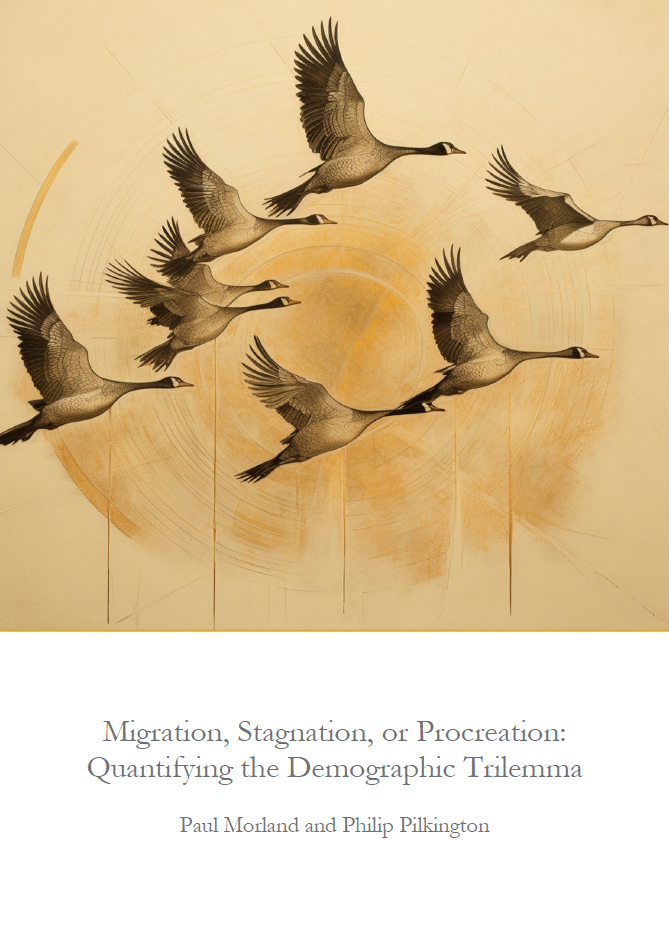Migration, Stagnation, or Procreation: Quantifying the Demographic Trilemma
“The only path to a thriving society lies in being prepared to have significantly more children than people in the United Kingdom, and much of the rest of the world, have had for decades.”
In this paper, Paul Morland and Philip Pilkington explain the “demographic trilemma” facing the UK, between the interplay of economic growth, migration levels, and fertility rates, demonstrating how procreativity poses the brightest future for the nation.
Summary of Research Paper
The Thesis
Who are you hoping will pay for your pension in your old age?
Demography is destiny. The children of today are the wealth creators of tomorrow.
The argument at the centre of this paper is that countries with low fertility rates have three options: to resign themselves to economic stagnation, to welcome mass migration, or to have more children.
This is a trilemma faced by many countries across the developed world where fertility rates are on a downward trend and have continued to fall steadily over the last 50 years. In most developed countries, rates are below the replacement level, meaning the average number of children born by each woman of childbearing age is below the 2.1 children needed to replace each parent. In the United Kingdom, for example, the fertility rate has fallen from over 2.9 in 1964 to 1.56 today.
But why do falling fertility rates matter? The answer lies in the trilemma: we cannot maintain economic growth, social cohesion, and low fertility rates. One has to give.
This paper examines the relationship between levels of migration, economic growth, and the number of children born in each country. Currently, the UK sustains its economic growth—despite having low fertility rates—through high levels of migration.
This paper models three different scenarios to show what will happen if the UK stays on its current course, or what could happen if it makes adjustments to migration levels and fertility rates. Each option comes with trade-offs related to migration, economic growth, and the number of children born.
The Model
This paper models three possible futures which the UK can choose:
Mass Migration: The model finds that if fertility levels in the UK do not change for the remainder of this century, the nation’s immigration ratio will need to rise to 37% by 2083 to maintain a sufficient working-age population. If fertility continues to rapidly decline, this figure will need to rise to 54%. Substantial evidence shows that very large increases in migration create income inequality and a stratified society. Such high migration levels could pose a real risk to social cohesion.
Economic Stagnation: In this scenario—where fertility rates do not rise, and mass migration is not used to supplement the workforce—it is unlikely that British economic growth would continue. The old-age dependency ratio would climb above 0.45 by mid-century, and by 2083 it would be well above 0.5. This means that in 60 years, there would be less than one worker for every retiree. The economic and social problems associated with such a scenario would be profound, risking widespread inability to afford to care for the elderly, or maintain a growing and dynamic economy.
Having More Children: This model presents the most hopeful outcome for the UK. In the long term, the dependency ratio would decrease, economic growth would be rejuvenated, and reasonable levels of migration maintained. The result would be a thriving, socially integrated, and economically innovative society which can care for those in their old age, whilst prioritising the needs of future generations.
What Now?
Whichever option the UK chooses for its future, it is clear that “business as usual” is unsustainable. Continuing to raise immigration to unprecedented levels cannot be done indefinitely, if we wish to create a society in which our communities can easily integrate with one another. Similarly, choosing to allow economic stagnation as the fertility rate plummets could lead to economic disaster, not least for the elderly in need of social care.
In contrast, having more children spells potential rebirth, and poses an opportunity for increased human flourishing once again in the West. Socially and economically, it is by far the most advantageous scenario for the future of our society. This paper is, therefore, a message of both hope and responsibility. The choice of couples to have two or three children should not be beyond the imaginable possibilities of modern societies if they are prepared to prioritise procreation and put front and centre of their lives the greatest joy there is: to bring new life into the world, to cherish and rear it with a sense of wonder and awe. While there are actions governments can take, ultimately societies will only thrive when individual citizens of childbearing age take on the very responsibilities which their parents and grandparents assumed, and without which they themselves would not have come into existence.

